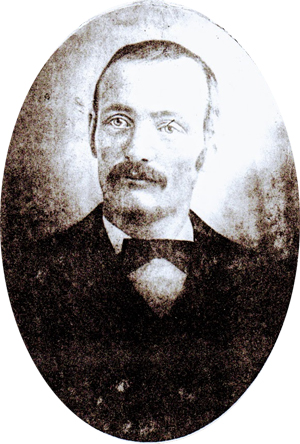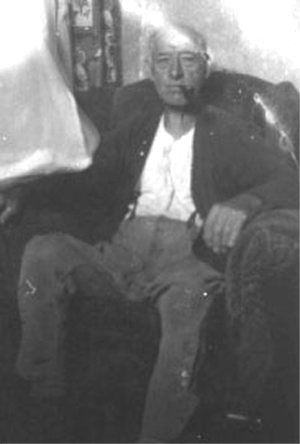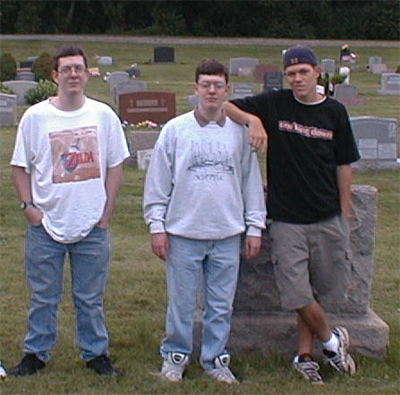-
John

John Harling The previous entry says our story begins with Annie Eaves, and that’s because her genealogy goes back the furthest. Unfortunately, Annie’s story is rather short. All I can find out about her is that she was born on the 11th of November, 1863, in Hambleton, Lancashire, married my great-grandfather, John Harling, produced four children, three of which survived into adulthood, was either a dutiful (or long-suffering) wife who followed her husband on his travels—with children in tow—before finally settling in Philadelphia, where she died on the 27th of October, 1921, at the age of 57.
She must have been a formidable woman but, unfortunately, the only person I knew who would have remembered her was my grandfather, and he refused to talk about the family except to remark that, “they were horse thieves, and they hung them all.”
John, on the other hand, was more of a presence in the family lore.
All my research points to him being illegitimate. He was born on the 28th of March, 1864, and his baptism certificate, dated the 5th of April 1865, states only that his mother was Elizabeth Harling. There is no mention of a father. Elizabeth was the daughter of John and Eliza, and she also had two other children, Thomas and Issac, both older than John. As far as I can tell, she never married.
John may or may not have been a domestic servant during his teenage years. I have a census sheet from 1881 with an age-appropriate John Harling listed, who was born in Caton (as John was) and was working as a indoor servant. This is appended by a note, from myself, saying only, “This is not John.”
This adds to the many occasions where I would like to go back in time to slap myself. There is no reason recorded as to why this shouldn’t be my great-grandfather, and at this time I can see no reason that it is not. So, we’ll call him an indoor domestic servant.
I have no record of when John and Annie got married, but it most likely was around 1883. I do have a family legend that says Annie’s family was not in favor of the union, feeling that she had ‘married down.’
The couple lived in Lancashire, in the Hambleton area, where John worked, at some point, as a plate-layer (a railroad job) and Annie gave birth to two children, Fanny and John Edward.
The next recorded mention of John is in February 1896, as a passenger on the Iberia, undertaking a 60-day voyage to Valparaiso, Chile, along with Annie, Fanny (now 11) and John Edward (now 6). Family legend has it that they were going to Argentina to homestead. The story goes that John got into a fight with a local over a cow and killed him and, as a result, was shipped back to England.
Whether this is true or not I can’t say, but at any rate, the following year saw Annie, Fanny and John Edward returning to Liverpool aboard the Orcana, and the 1901 census confirms that John was now with them in England, working as a laborer in Thornton, Lancashire.
Whatever misadventures they’d had in Argentina didn’t put John off. Six years later, in 1907, he set sail for America on the Noordland, arriving in Philadelphia on the 18th of April. Annie arrived the following month with her youngest child, James Percival, age 5—my grandfather. Her other children, now adults, made their own way over.
The family was met by Thomas Harling, John’s brother, and there is much speculation about him. Now, John did have a brother named Thomas, but I was always told that Thomas Harling was no relation to us. He was just a friend who adopted the name and went to America to get away from his wife. I have seen documents suggestion that this Thomas returned to England at some point to bury his wife, and other documents that list him as “single” so the story could be true.
Thomas Harling…or is it? The final clue is Thomas’ death certificate. John lists Thomas’ date of birth as the 28th of Aug 1863, just seven months prior to his own birthday. It seems highly unlikely that he could be his brother, especially as his real brother Thomas was eight years older than John. Again, it’s a story too good to sully with close examination. Better to just accept the legend as true.
Whatever their family relationship, John, Thomas and Annie set up a restaurant and catering business and did fairly well for themselves.
The only other photo I have of Uncle Tom. After Annie died, in October 1921 at the age of 57, John went to live with his son, John Edward, and his growing family (they had nine children), and Thomas eventually ended up living in Kinderhook, where John’s other son, Percy, lived. He took a job, and board, at the Tate farm, working as a coachman and horse trainer. My father remembers him as a miserable old man, but that’s the same thing he said about his grandfather, John, and it’s also the same thing I remember about Dad and, most likely, the only thing my grandsons will remember about me, so I guess we’re all even.

John Harling My father told me that John had a sore on his leg that wouldn’t heal. It was from a carriage accident in England. John always said, according to my father, that when the sore healed, he would die. In the final year of this life, the story goes, the sore healed.
John died on the 1st of July, 1943, at the age of 79, and was buried with Annie in lot 50 #625 in Fernwood Cemetery, Delaware County, Pennsylvania.
Where John and Annie are buried. 
My three boys–Ben, Michael and Mitchell–at John’s grave in July 2000. The gravestone Mitch is leaning on is not John’s. He, and the rest of the family in the plot, have no markers.